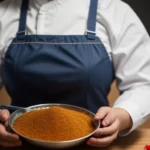From Churros to Gazpacho: The Sweet and Savory Sides of Spanish Food
Introduction
– Spanish cuisine is known for its bold flavors, fresh ingredients, and diverse regional specialties.
– From churros dipped in chocolate to refreshing gazpacho soup, Spanish food offers a wide array of sweet and savory dishes that appeal to all palates.
1. A Brief History of Spanish Cuisine
– Spanish cuisine has been influenced by various cultures and civilizations over the centuries, including the Romans, Moors, and Sephardic Jews.
– The use of olive oil, garlic, and tomatoes is characteristic of Spanish cuisine, as well as a reliance on fresh seafood and local produce.
2. The Role of Tapas in Spanish Cuisine
– Tapas are small, shareable dishes that are a cornerstone of Spanish dining culture.
– They can be savory or sweet, hot or cold, and range from fried calamari to marinated olives to sweet almond tarts.
3. Churros: A Sweet Spanish Treat
– Churros are a popular street food in Spain, made from deep-fried dough that is crispy on the outside and fluffy on the inside.
– They are typically sprinkled with sugar and cinnamon and served with a rich chocolate dipping sauce.
4. Paella: Spain’s Iconic Rice Dish
– Paella is a traditional Spanish rice dish that originated in the Valencia region.
– It is typically made with rice, saffron, vegetables, and a variety of meats or seafood, such as chicken, rabbit, shrimp, or mussels.
5. Gazpacho: The Ultimate Summer Soup
– Gazpacho is a cold tomato soup that is perfect for hot summer days.
– It is made with ripe tomatoes, cucumbers, bell peppers, onions, garlic, olive oil, and vinegar, and is typically served chilled with a garnish of croutons or diced vegetables.
6. Pisto: Spanish Ratatouille
– Pisto is a Spanish vegetable stew that is similar to the French dish ratatouille.
– It is made with sautéed onions, bell peppers, zucchini, eggplant, and tomatoes, and is typically seasoned with Spanish paprika and served as a side dish or tapa.
7. Tortilla Española: The Spanish Omelette
– Tortilla española, also known as tortilla de patatas, is a classic Spanish omelette made with eggs, potatoes, and onions.
– It is cooked in olive oil until golden and crispy on the outside, and is typically served as a tapa or light meal.
8. Crema Catalana: Spain’s Answer to Crème Brûlée
– Crema catalana is a traditional Spanish dessert similar to crème brûlée.
– It is made with milk, sugar, egg yolks, and cornstarch, flavored with cinnamon and lemon zest, and topped with a caramelized sugar crust.
9. Jamón Ibérico: Spain’s Famous Cured Ham
– Jamón ibérico is a type of cured ham that is a prized delicacy in Spain.
– It is made from the meat of the Iberian pig and is aged for several years, resulting in a rich, complex flavor and a melt-in-your-mouth texture.
10. Turron: A Spanish Holiday Treat
– Turrón is a traditional Spanish nougat candy that is typically enjoyed during the holiday season.
– It is made with almonds, honey, and sugar, and comes in various flavors and textures, such as hard and crunchy or soft and chewy.
11. Patatas Bravas: Spicy Fried Potatoes
– Patatas bravas are a popular Spanish tapa made with fried potatoes that are topped with a spicy tomato sauce and garlic aioli.
– They are crispy on the outside and tender on the inside, with a bold and zesty flavor that is irresistible.
12. Pescado Frito: Spanish Fried Fish
– Pescado frito, or fried fish, is a popular dish in coastal regions of Spain.
– It is typically made with small fish such as anchovies or sardines, coated in flour or batter and deep-fried until crispy and golden brown.
13. Empanadas: Spanish Hand Pies
– Empanadas are savory pastries that are popular throughout Spain and Latin America.
– They are made with a flaky pastry dough that is filled with a variety of savory fillings, such as meat, vegetables, or cheese, and can be baked or fried.
14. Sangria: Spain’s Refreshing Wine Cocktail
– Sangria is a traditional Spanish wine cocktail made with red or white wine, fresh fruit, and a sweetener such as sugar or honey.
– It is typically served chilled over ice and is a popular drink to enjoy on hot summer days.
15. Conclusion
– Spanish cuisine is a rich and diverse culinary tradition that offers a wide range of sweet and savory dishes to suit every taste.
– From churros to gazpacho, Spain’s food reflects the country’s vibrant culture, history, and passion for good food.
FAQs about “From Churros to Gazpacho: The Sweet and Savory Sides of Spanish Food”
- What makes “From Churros to Gazpacho: The Sweet and Savory Sides of Spanish Food” a captivating exploration of Spanish cuisine? This book offers a delightful journey through the diverse flavors of Spanish cuisine, showcasing both the sweet and savory sides of this rich culinary tradition.
- Which dishes are featured in the sweet and savory sides of Spanish food in this book? “From Churros to Gazpacho” features a wide array of dishes from Spanish cuisine, including iconic savory delights like paella, tapas, and tortilla española, as well as delectable sweet treats like churros con chocolate, flan, and turron.
- How does this book highlight the cultural and regional diversity of Spanish cuisine? This book celebrates the cultural and regional diversity of Spanish cuisine by exploring the unique flavors, ingredients, and cooking techniques from various regions across Spain, from the coastal delights of Andalusia to the hearty dishes of Castilla-La Mancha.
- Are there insights into the history and traditions behind Spanish dishes in this book? Yes, “From Churros to Gazpacho” provides insights into the rich history and culinary traditions behind Spanish dishes, offering readers a deeper understanding of the cultural significance of food in Spain.
- Can readers expect to find recipes and cooking tips for preparing Spanish dishes at home in this book? Absolutely! This book includes a variety of recipes and cooking tips for preparing both sweet and savory Spanish dishes at home, allowing readers to recreate the flavors of Spain in their own kitchens. Whether you’re craving a traditional Spanish paella or a refreshing gazpacho, this book has you covered.
Advantages:
- Engaging Language: The title “From Churros to Gazpacho: The Sweet and Savory Sides of Spanish Food” uses engaging language that immediately captures the reader’s attention, suggesting a delightful exploration of both sweet and savory Spanish dishes.
- Culinary Exploration: By highlighting a range of Spanish dishes, the title encourages readers to explore the diverse flavors, ingredients, and cooking techniques of Spanish cuisine, fostering a deeper appreciation for the culinary traditions of Spain.
- Educational Value: The title offers readers valuable insights into the breadth and depth of Spanish food culture, providing them with knowledge about iconic dishes like churros and gazpacho, as well as lesser-known specialties that contribute to the richness of Spanish gastronomy.
- Gastronomic Adventure: Readers can anticipate embarking on a culinary journey through Spain, discovering the unique blend of sweet and savory flavors that define Spanish cuisine, from indulgent desserts to savory soups and stews.
- Inspiration for Dining and Cooking: The title may inspire readers to seek out Spanish restaurants to sample these dishes or to try their hand at cooking Spanish recipes in their own kitchens, encouraging culinary exploration and experimentation with Spanish flavors.
Disadvantages:
- Oversimplified Focus: While the title emphasizes the sweet and savory sides of Spanish food, it may oversimplify the complexity of Spanish culinary traditions and overlook regional variations and specialties, potentially limiting the breadth of the discussion.
- Cultural Stereotyping: Focusing solely on churros and gazpacho may perpetuate stereotypes about Spanish cuisine, potentially overlooking the diversity of regional cuisines and culinary influences within Spain.
- Limited Scope: The title may not cover every aspect of Spanish cuisine’s sweet and savory offerings in depth, potentially leaving out certain dishes or culinary traditions that could provide a more comprehensive understanding.
- Accessibility: Some Spanish dishes may be difficult to find outside of Spain or major culinary hubs, limiting the practicality of exploring the sweet and savory sides of Spanish food for readers in other regions.
- Audience Engagement: While the title appeals to readers interested in culinary exploration and Spanish cuisine, it may not attract those seeking a more focused or specialized discussion of specific Spanish dishes or culinary topics.
















